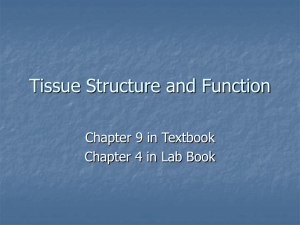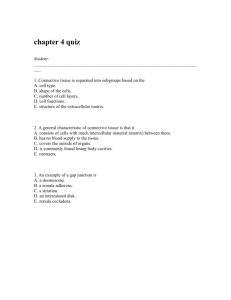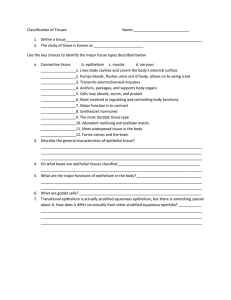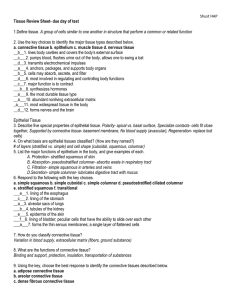Histology Checklist
advertisement
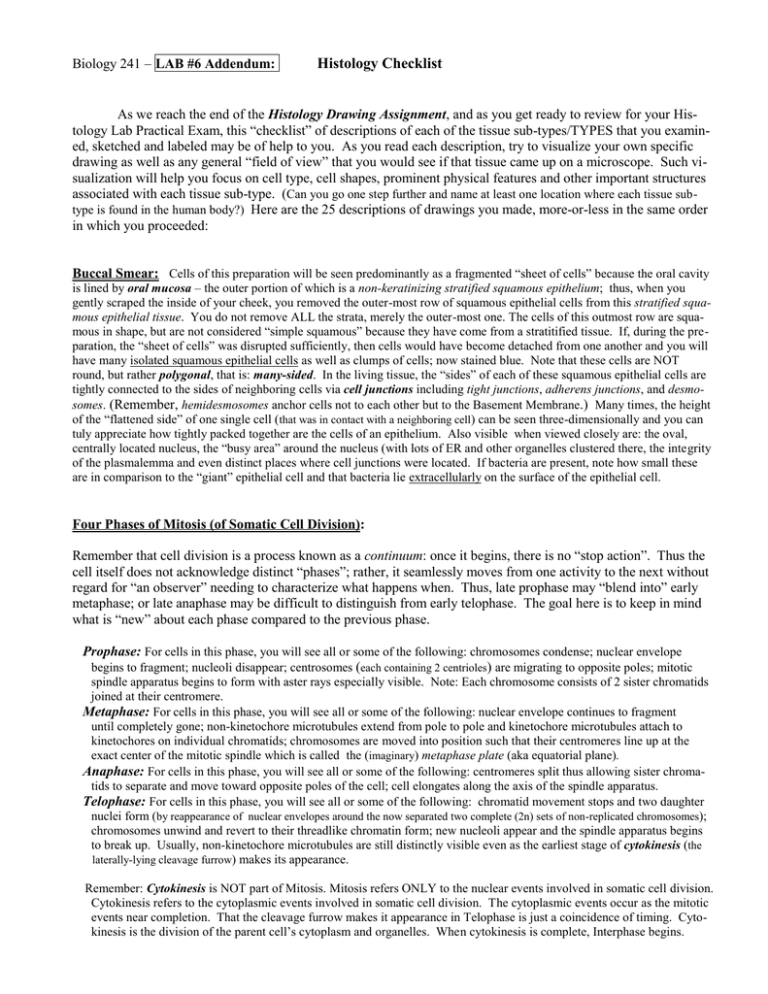
Biology 241 – LAB #6 Addendum: Histology Checklist As we reach the end of the Histology Drawing Assignment, and as you get ready to review for your Histology Lab Practical Exam, this “checklist” of descriptions of each of the tissue sub-types/TYPES that you examined, sketched and labeled may be of help to you. As you read each description, try to visualize your own specific drawing as well as any general “field of view” that you would see if that tissue came up on a microscope. Such visualization will help you focus on cell type, cell shapes, prominent physical features and other important structures associated with each tissue sub-type. (Can you go one step further and name at least one location where each tissue subtype is found in the human body?) Here are the 25 descriptions of drawings you made, more-or-less in the same order in which you proceeded: Buccal Smear: Cells of this preparation will be seen predominantly as a fragmented “sheet of cells” because the oral cavity is lined by oral mucosa – the outer portion of which is a non-keratinizing stratified squamous epithelium; thus, when you gently scraped the inside of your cheek, you removed the outer-most row of squamous epithelial cells from this stratified squamous epithelial tissue. You do not remove ALL the strata, merely the outer-most one. The cells of this outmost row are squamous in shape, but are not considered “simple squamous” because they have come from a stratitified tissue. If, during the preparation, the “sheet of cells” was disrupted sufficiently, then cells would have become detached from one another and you will have many isolated squamous epithelial cells as well as clumps of cells; now stained blue. Note that these cells are NOT round, but rather polygonal, that is: many-sided. In the living tissue, the “sides” of each of these squamous epithelial cells are tightly connected to the sides of neighboring cells via cell junctions including tight junctions, adherens junctions, and desmosomes. (Remember, hemidesmosomes anchor cells not to each other but to the Basement Membrane.) Many times, the height of the “flattened side” of one single cell (that was in contact with a neighboring cell) can be seen three-dimensionally and you can tuly appreciate how tightly packed together are the cells of an epithelium. Also visible when viewed closely are: the oval, centrally located nucleus, the “busy area” around the nucleus (with lots of ER and other organelles clustered there, the integrity of the plasmalemma and even distinct places where cell junctions were located. If bacteria are present, note how small these are in comparison to the “giant” epithelial cell and that bacteria lie extracellularly on the surface of the epithelial cell. Four Phases of Mitosis (of Somatic Cell Division): Remember that cell division is a process known as a continuum: once it begins, there is no “stop action”. Thus the cell itself does not acknowledge distinct “phases”; rather, it seamlessly moves from one activity to the next without regard for “an observer” needing to characterize what happens when. Thus, late prophase may “blend into” early metaphase; or late anaphase may be difficult to distinguish from early telophase. The goal here is to keep in mind what is “new” about each phase compared to the previous phase. Prophase: For cells in this phase, you will see all or some of the following: chromosomes condense; nuclear envelope begins to fragment; nucleoli disappear; centrosomes (each containing 2 centrioles) are migrating to opposite poles; mitotic spindle apparatus begins to form with aster rays especially visible. Note: Each chromosome consists of 2 sister chromatids joined at their centromere. Metaphase: For cells in this phase, you will see all or some of the following: nuclear envelope continues to fragment until completely gone; non-kinetochore microtubules extend from pole to pole and kinetochore microtubules attach to kinetochores on individual chromatids; chromosomes are moved into position such that their centromeres line up at the exact center of the mitotic spindle which is called the (imaginary) metaphase plate (aka equatorial plane). Anaphase: For cells in this phase, you will see all or some of the following: centromeres split thus allowing sister chromatids to separate and move toward opposite poles of the cell; cell elongates along the axis of the spindle apparatus. Telophase: For cells in this phase, you will see all or some of the following: chromatid movement stops and two daughter nuclei form (by reappearance of nuclear envelopes around the now separated two complete (2n) sets of non-replicated chromosomes); chromosomes unwind and revert to their threadlike chromatin form; new nucleoli appear and the spindle apparatus begins to break up. Usually, non-kinetochore microtubules are still distinctly visible even as the earliest stage of cytokinesis (the laterally-lying cleavage furrow) makes its appearance. Remember: Cytokinesis is NOT part of Mitosis. Mitosis refers ONLY to the nuclear events involved in somatic cell division. Cytokinesis refers to the cytoplasmic events involved in somatic cell division. The cytoplasmic events occur as the mitotic events near completion. That the cleavage furrow makes it appearance in Telophase is just a coincidence of timing. Cytokinesis is the division of the parent cell’s cytoplasm and organelles. When cytokinesis is complete, Interphase begins. Biology 241 – LAB #6 Addendum – continued Page Two Six Epithelia sub-types: Simple Squamous Epithelium: Single layer of closely packed, very flat, polygonal cells whose basal surface is on the Basement Membrane and whose apical surface is adjacent to the lumen. Each squamous cell has a centrally located nucleus, and the central, nuclear area is where the cell’s height is greatest. The cytoplasm thins out toward the cell periphery. Simple Cuboidal Epithelium: Single layer of very closely packed cube-shaped cells (ie, height = width = depth) whose basal surface is on the Basement Membrane and whose apical surface is adjacent to the lumen. Each cuboidal cell has a centrally located nucleus and the cytoplasm is distributed equidistantly around it. Apical surfaces may appear to “dome out” into the lumen space, since this is the only surface of these epithelial cells where some distention can occur. Simple Columnar Epithelium: Single layer of closely packed, tall, column-like cells whose basal surface is on the Basement Membrane and whose apical surface is adjacent to the lumen. (There may or may not be specialized structures at the apical surface of these columnar cells: if cilia are present, the tissue sub-type name becomes “Ciliated Simple Columnar epithelium; if cilia are not present: “Nonciliated Simple Columnar epithelium” or just “Simple Columnar epithelium”. Nonciliated Columnar epithelial cells may have another apical modification called microvilli . Collectively, the zone of microvilli is referred to as a brush border.) Entire columnar cells in this type of epithelium may undergo differentiation into single-celled glands called “Goblet cells” which produce a mucoid secretion: mucus. (Goblet cells DO NOT have microvilli nor cilia at their apical surface!!) Each columnar cell has a nucleus near the base of the cell (in the lower 1/3) and these nuclei all seem to “line up” at the same level. Pseudostratified, Ciliated, Columnar Epithelium: As the name implies: this is NOT a “true stratified tissue”, rather it is a simple tissue in the classic sense because ALL cells are attached to the Basement Membrane. It is just that not all cells reach the apical surface, and the nuclei of the cells are at different levels. The cells are very closely packed, and most cells are tall and columnar, but some are short, gothic-pyramid-shaped. Goblet cells are quite numerous. Stratified Squamous Epithelium: Several layers of very closely packed, flat, polygonal cells that stay nucleated from basal layer to apical layer in non-keratinizing st. sq. epi. You examined non-keratinizing stratified squamous epithelium in which the cells of the deeper layers, including the basal layer, are cuboidal to columnar in shape and the definitive squamous shape appears in the apical layer and several layers deep to it. Cells from the basal layer replace surface cells as they are lost; thus there is a continuum of movement of these cells as the more superficial ones are pushed up and slough off. Note: The nucleus of these epithelial cells stays intact and viable throughout the entire life cycle; thus even the apical-most Layer of squamous cells will be nucleated. In keratinizing stratified squamous epithelium, the epithelial cells are called keratinocytes (as they produce the water-proofing protein, keratin) and various distinct layers (strata) of them are identifiable including basale, spinosum, granulosum, lucidum and corneum in thick skin, and all but the stratum lucidum in thin skin. (In the stratum granulosum of keratinizing st. sq. epi., the nucleus of each keratinocyte degenerates as part of apoptosis: an orderly, genetically-programmed cell death process and the cell becomes a “shell” filled with keratin, thus in any stratum superficial to the granulosum, nuclei will be absent.) ▪ The cells of the single row of stratum basale (aka stratum germinativum) are quite cuboidal in shape and are very small. These basal cells constitute the stem cells and undergo cell division to produce new keratinocytes. You may see various mitotic phases if you look closely enough! ▪ The cells of the 8 - 10 rows of stratum spinosoum are polygonal (many-sided) in shape and appear to be covered with thorn-like spines. (This is an artifact of histologic preparation in which the plasmalemma of each cell shrinks a bit, thus exaggerating the areas where desmosomes hold adjacent cells together.) ▪ The cells of the 3 – 5 rows of stratum granulosum are flattened keratinocytes and have organelles that are beginning to degenerate and whose cytoplasm accumulates lamellar granules and the protein keratohyalin which together convert tonofilaments into keratin and release a lipid-rich, water-repellent secretion. ▪ The cells of the 3 – 5 rows of stratum lucidum are clear, flat, dead keratinocytes with large amounts of keratin. This stratum is present only in skin of the fingertips, palms, and soles. ▪ The cells of the 25 – 30 rows of stratum corneum are dead, flat keratinocytes that are mere “shells” filled with the protein keratin. Note: The whole process by which cells form in the stratum basale, rise to the surface, become keratinized, and slough off takes about four weeks in an average epidermis of 0.1 mm (0.0004 “) thickness. The rate of cell division in the stratum basale increases when the outer layers of the epidermis are stripped away, as in abrasions and burns. The mechanisms that regulate this remarkable growth are not yet well understood, but hormone-like proteins such as epidermal growth factor (EGF) play a major role. Transitional Epithelium: Several layers of very closely packed cells whose shape is variable; that is, the cell-shape transitions from one layer to the next AND even within the apical-most layer, the cells transition from large/rounded (“Balloon cells”) in the empty urinary bladder to elongated/flattened (“Squamous”) in the distended urinary bladder. (Remember, you did not examine Stratified Cuboidal Epithelium nor Stratified Columnar Epithelium ) Biology 241 – LAB #6 Addendum – continued Page Three Nine Connective Tissue sub-types: Areolar Connective Tissue: Cell type: Fibroblasts manufacture this C.T. sub-type whose matrix consists of nearly equal amounts of all three protein fibers (collagen, elastic, and reticular) that come to lie in a “pick-up sticks” manner embedded in the semifluid ground substance. Other transient cells that are associated with this tissue sub-type are macrophages which “wander through” to surveill for foreign matter, plasma cells producing antibodies, adipocytes, and mast cells.) The fibroblasts remain quite “plump” as they go through their life cycle. Collagenous Connective Tissue: Cell type: Fibroblasts manufacture this C.T. sub-type whose matrix consists of massive quantities of collagen protein fibers (nearly displacing all the ground substance) that come to align themselves in parallel fashion and even arrange themselves into bundles. The fibroblasts become extremely compressed - with nuclei that look like dash marks - once entrapped in all the matrix, and the cells seem to be arranged in regularly arranged rows or periods. Grossly, the matrix looks shiny white due to the structured arrangement of collagen. (This tissue sub-type is also called Dense Regular Connective Tissue) Note: The Dense Irregular Connective Tissue is much like the above for cell type (Fibroblasts) and matrix make-up; however, the difference is that the massive quantities of collagen are more randomly arranged and the bundles alternately orient themselves in rows perpendicular to one another. Elastic Connective Tissue: Cell Type: Fibroblasts manufacture this C.T. sub-type whose matrix consists of huge quantiThe elastic bundles further fuse to form elastic lamellae (sheets of elastic material). The fibroblasts become extremely ties of elastic protein fibers, both individual ones and those that align to form bundles, embedded in the ground substance. compressed – with nuclei that look like dash marks – once entrapped in all the matrix. Furthermore, since the elastin is quite “squiggly”, the fibroblasts look flattened and squiggly, too. Reticular Connective Tissue: Cell type: Fibroblasts manufacture this C.T. sub-type whose matrix consists of huge quantities of branching reticular fibers that form a network of interlacing structure within the ground substance. The “network” is very three-dimensional in that it can “trap” cells in every direction. Thus it is ideally suited to form the supporting framework of the liver, spleen, lymph nodes, myeloid ( red bone marrow) and reticular lamina of the Basement Membrane. Adipose Connective Tissue: Cell type: Adipocytes, cells specialized to store triglycerides (fats) having a large, centrally located droplet which, as it increases, displaces the nucleus extremely to one side of the cell and the cytoplasm to a mere “rim” around the periphery. Adipocytes pack extremely closely together; and although each cell is quite rounded, because the pack together, they compress one another. Since round cells do not pack without some spaces remaining, there are still interstitial spaces occupied by numerous capillaries, lymphatics, and ground substance. Hyaline Cartilage Connective Tissue: Cell type: Chondrocytes manufacture this C.T. sub-type whose matrix consists of predominantly ground substance with a few fine collagen protein fibers embedded in it. Each chondrocyte lies within its own lacuna containing a small, but very important, lacunar space. (The boundary of the lacuna is one and the same as the “edge” of matrix components that came to be laid down once exocytosed from the chrondrocyte. Instead of actually touching the chondrocyte, the matrix components come to lay down a tiny distance away from the chondrocyte plasmalemma, thus leaving a small space that comes to be occupied by nutrient fluid to give each chondrocyte a “fluid environment” in which to exchange nutrients and waste products. The matrix looks bluish-white and quite shiny. This sub-type of cartilage is the most abundant in the body, is how all the cartilage C.T. sub-types begin; and is also what the lay person calls “gristle”. Fibrocartilage Connective Tissue: Cell type: Chondrocytes manufacture this C.T. sub-type which starts out as hyaline cartilage C.T. but whose chondrocytes differentiate in such a way as to produce huge numbers of collagen protein fibers which they exocytose and thus modify the matrix which now consists of huge numbers of collagen protein fibers and collagen bundles that come to overlay the ground substance. Again, each chondrocyte is isolated within its own lacuna which creates a lacunar space. Elastic Cartilage Connective Tissue: Cell type: Chondrocytes manufacture this C.T. sub-type which starts out as hyaline cartilage C.T. but whose condrocytes differentiate in such a way as to produce huge numbers of elastic protein fibers which they exocytose and thus modify the matrix which now consists of huge numbers of elatic fibers and bundles that come to overlay the ground substance. These elastic fibers often “overshoot” the ground substance and embed partially in the perichondrium which helps attach the perichondrium more securely to the mass of cartilage C.T. Osseous (Bone) Connective Tissue: Cell type: Osteoblasts manufacture this C.T. sub-type, but once the osteoblasts have secreted sufficient matrix (ground substance and protein fibers which for osseous C.T. is called osteoid) One Organ (the Cutaneous Membrane): The Skin: The skin (aka the cutaneous membrane, aka the integument) is a true membrane in that it consists of an epithelial layer (the epidermis) and a connective tissue layer (the dermis). There is also another connective tissue layer closely associated with the dermis, the hypodermis (aka subcutaneous layer, aka “sub-Q”, aka the Biology 241 – LAB #6 Addendum – continued Page Four superficial fascia). The epidermis is a keratinized, stratified squamous epithelium, with 4 – 5 strata: basale, spinosum, granulosum (lucidum - only in thick skin; absent in thin skin), and corneum. It is completely avascular. The dermis consists of two regions: 1/5th papillary region (composed of areolar connective tissue and delicate elastic fibers) and 4/5ths reticular region (composed of dense, irregular connective tissue, collagen bundles and coarse elastic fibers). The surface area of the dermal-epidermal interface is made vastly larger due to the dermal papillae of the papillary region; and it is why the skin resists abrasion as well as it does (the epidermis is “anchored” by virtue of interdigitating with the dermal papillae.) The blood vessels, nerves, hair follicles, arrector pili muscles, and sudoriferous glands are found in the dermis. Review the 4 important populations of cells within the skin: keratinocytes, melanocytes, Langerhans cells, and Merkel’s cells and the distinct function of each. Three Muscle Tissue sub-types: Skeletal Muscle Tissue: Attaches to bones (with some exceptions, esp. in the head/neck) via tendons; has long, cylindrical myofibers that are multinucleated; exhibits striations due to the alignment of myofibrils (sarcomere for sarcomere) within; multinucleated (with up to hundreds of nuclei) with these being forced out to the periphery of the cell just deep to the sarcolemma; each myofiber is surrounded by a very thin layer of areolar connective tissue referred to as endomysium. Cardiac Muscle Tissue: Forms most of the heart wall; has branching-cylindrical myofibers each of which has one single centrally located nucleus around which is visible a distinct perikaryon region; exhibits striations due to the alignment of myofibrils (sarcomere for sarcomere) within; each myofiber is surrounded by a very thin layer of areolar c.t. = endomysium. Smooth Muscle Tissue: Is found in the walls of hollow internal structures (blood vessels and viscera); has spindle-shaped (aka fusiform) myofibers each of which has one single, centrally located nucleus in the thickest part of the cell; no striations are present because the contractile proteins within are not arranged into sarcomeres – thus there are no myofibrils to align and the sarcoplasm looks “smooth” rather than having a banded-pattern. Nervous Tissue: Giant Multipolar Neurons (and neuroglial cells): For the most part, the biologic stain used for histologic preparation of nervous tissue results in the cell body region (soma) of neurons being blue and the neuron processes (one axon and multiple dendrites) being pinkish. The periphery of the soma is quite irregular due to the many neuron processes that eminate from it: only ONE of these processes is the axon, and it will extend from the axonal hillock which is supported by the largest amount of cytoplasm (thus, if there IS an axon in the particular plane of section of the neuron you are looking at, it will be the largest of the processes. Remember, not every neuron in your specimen will be “sliced” in the exact plane of its axon – thus, be sure to LOOK for one that is!!)

